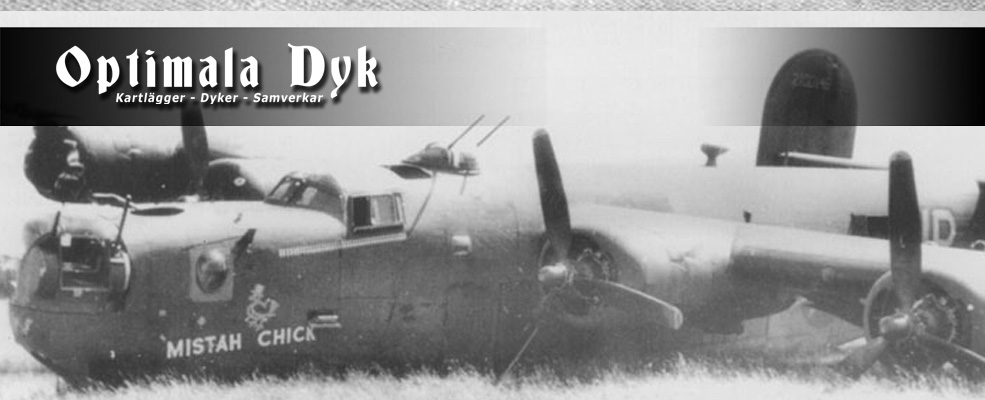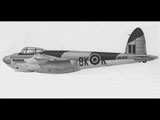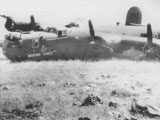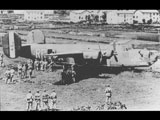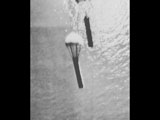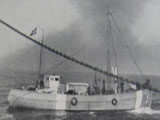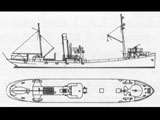War in the Kattegat 1939-1945.
A article in seven parts.
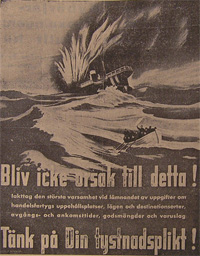
Part 6: 1944
In 1944, Allied bombing reached its peak. From August and onwards, Halifax bombers from the 58 and 502 squadrons departed from the Hebrides and carried out anti-submarine missions in the Kattegat, while Liberator bombers from the 86, 206, 224, 311 and 547 squadrons departed from Scotland with the aim of preventing German ore transports from Sweden that were transported from Norway to Germany. The 18th group had so-called "Strike wings", which were units that specialized in ship attacks during the day. Radar was used to detect ships and the aircraft were equipped with anti-tank missiles and 20 mm cannons to be able to fight the German ships. Banff Airport in the north-east of Scotland with 248, 235 and 143 squadrons were stationed there under the name "Banff Strike Wing" and a Norwegian unit, 333, which flew reconnaissance for Banff. All planes from Banff were Mosquito planes and the area of operation was determined between Oslo and Anholt and east of the 10 degrees latitude. Often two planes flew from 333 ahead of the main force from Banff and scouted and reported back what they spotted after which the main force went to attack. In October, the Banff Strike Wing carried out a total of 27 attacks on ships in the Kattegat, and in November, 58 and 502 Halifax Squadrons carried out 20 attacks at night. During December, the weather was very bad, and it was therefore not possible to carry out as many attacks.
On January 1, the German steamship Hecksee of 865 grt hit a mine and sank off Anholt.
In January, the British managed to crack the German code "Potsdam", which the Germans had used since April 1943 and continued to use until the end of the war for radio messages in the Kattegat, Skagerrak and the Baltic Sea. As the code was broken, the Allies were able to understand the German messages transmitted over the radio.
On January 5, several large British and American bombers passed Halmstad on their way south to bomb Stettin. After midnight, they passed on their way back and the local air force opened fire but did not hit any planes.
Between 10-26 February, the RAF carried out several mine laying missions during flights in the Kattegat for 14 nights.
On February 27, a German Junker 88A-4, built by Junkers Flugzeug und Motorenwerke AG, was shot down outside Århus. The crew of four men died and were never found.
Between 1 April and 31 June, the RAF carried out several mine laying missions during flights in the Kattegat for a total of 95 nights.
On April 7, a British Mosquito plane with serial number MM247 crashed in the Kattegat after being on a photo reconnaissance mission over northern Germany. On April 12, one of the two crew members was found dead at Vendelsö and buried in Väröbacka.
On May 8, Halifax LL192 crashed in the Kattegat when it was on its way to Denmark.
On June 20, two B-24Js, American Liberator bombers, "Princess Konocti" and "Mistah Chick", made an emergency landing in Halmstad after dropping bombs on Pölitz. Both crews survived.
Between 1-31 August, the RAF carried out several mine laying missions during flights in the Kattegat for 25 nights.
On 11 August, the cargo ship Erling Lindöe, at the time on its way from Ballangen in Norway to Holtenau in Germany with kis, struck a mine outside Nidingen and sank.
On 12 August, the Norwegian steamer Elin was blasted by a mine 5 nautical miles west of Nidingen. The entire crew perished. The ship was 146 grt and was built at K.Skaluren in Rosendal in Norway in 1908.
On 13 August, the entire crew on board the Swedish fishing trawler Gotland, built at Hönöröd, died after a mine found in the trawl blew up the vessel. The crew of five men died.
On 22 August, the cargo ship M / S Eisbär, 382 grt , sank to the bottom after hitting a mine outside Öckerö. At the time, the ship was carrying munitions.
On the morning of August 26, the Swedish cargo ship Titti was blown up by a mine outside Nidingen. The ship was at the time traveling between Lübeck and Gothenburg with a load of coke.
On the night of August 30, Stettin and Königsberg were attacked in Germany by British and American bombers. During the night, the largest accumulation of planes during the war passed Sweden on its way to their target area in Germany. The planes came in from the west at 11 pm and from Falkenberg in the north to Skåne in the south, the anti-aircraft guns and tracer light grenades exploded in the darkness of the night.
The British bomber Lancaster ME592 crashed at midnight with a bang in Skälderviken outside Vejbyudde after exploding in the air. The plane burned for a while in the surface before the fire went out and the aircraft sank. The strong light of fire was clearly seen from Halmstad. In Hallandsposten, it was reported that the anti-aircraft guns during the night had slammed with the richest anti-aircraft gun ever thundered away in the area. Five planes were shot down in and around Halmstad, Båstad, Helsingborg, Markaryd and Ljungby. The planes had gone at low altitude but due to cloud formation it was difficult to see the plane but the air defence fired heavy barricades and some of the planes were hit by the Swedish air defence. From the high-lying villas on the hillside by the hospital in Halmstad, the battle was could be clearly observed. In Båstad, an American Lancaster bomber caused great devastation when it crashed with the bomb load left on board. 7 of the 8 crew members on board survived after jumping off the plane with a parachute. After landing, they were taken care of by the military. The chief pilot, who was from Canada, said that together with 8 other planes they had flown in from the west with an easterly course. Over Denmark, German fighter planes had met and attacked and over the Sound, two pursuing fighter planes had received hits, after which the plane caught fire and when they saw the Swedish coast, they decided to jump out of the plane. The pilot was unsure if the 8 had jumped or not. The pilot saw when the plane crashed, and the five-ton bomb exploded when the plane crashed. When the pilot landed, he was offered coffee and breakfast by locals before the Swedish military picked him up. Hallandsposten wrote that all crew members were "magnificent young warrior types" aged 20-30 years.
At 0020 hrs on 30 August, a Lancaster ED327 burst into flames in the Kattegat after being attacked by a German fighter plane. All 7 crew members died.
On 30 August, the British Lancaster NE144 made an emergency landing in the Kattegat outside Anholt. The plane was on its way to Stettin in Germany at the time when it was attacked and damaged by German fighter planes shortly after midnight. Some crew members survived unharmed and were able to put themselves in the life raft. In the morning, the crew was seen from Anholt and the pilots were taken prisoners by the local German garrison on Anholt.
On 30 August, a British Lancaster KB709 crashed in the Kattegat southwest of Anholt shortly after the above plane. The plane was on its way to Stettin when it was attacked by a German fighter plane and shot down. Everyone on board died in the crash.
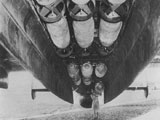
The bomb load under a Lancaster plane.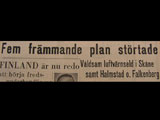
Hallandsposten wrote about the violent anti-aircraft fire as a man resigned from Halmstad
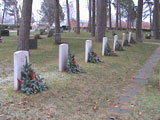
Six crew members from downed bombers on the night of September 30, 1944 are buried at Skogskyrkogården in Falkenberg, as well as a crew member who was found a few weeks earlier and who is still unidentified.
Between 6-19 September, the RAF carried out several mine laying missions during flights in the Kattegat for 6 nights.
On September 7, the German troop transport ship Westfalen left Norway to go to Germany with troops and prisoners. The next day, September 8, the ship was torpedoed and sank just northwest of Hönö.
At three o'clock on the night of September 8, the Norwegian steamer Kong Alf of 1070 grt was on its way from Rügenwalde to Oslo when they ran a leak outside Varberg in the strong storm, 25 m/s, which prevailed. When the water began to penetrate the ship, everyone was put to the pumps and emergency flares were sent up. A moment later, however, the water penetrated the engine room and the machines stopped. The non-manoeuvrable ship was seen from land during the morning and the lifeboat station in Bua was notified but they did not have a lifeboat available because it was in another place on behalf of the Crown. Instead, the lifeboat in Galtebäck was contacted at 6 am which came to the rescue, however delayed due to engine problems. They got out just in time, at 1 pm, to see the last of the bow stick up where everyone on board was, before the ship sank. The entire crew and the German guard on board were rescued. At 3 pm they arrived at the harbour in Varberg where the rescued got food and clothes. The position was stated to be just west of Södra Horta at the height of Bua harbour. At the time of the sinking, the ship was carrying a load of 900 tonnes of rye.
On October 1, the Swedish fishing boat Nordstjärnan of 46 grt was blown up when traveling from Simrishamn to Skredsvik. The ship was built in 1933 in Skredsvik. Five people died.
On October 1, the Norwegian ship Hartmut fell victim to British mines outside Ålborg, killing two crew members. The ship was built in 1938 at Eriksberg Mrk Verkst A / S in Gothenburg and measured 63 m long and 9 m wide and was 2713 grt.
On October 3, the German Vs-906 was sunk by a mine laid by British aircraft northwest of Anholt. In 1920, the ship was built at the Reichswerf / Deutche werke in Kiel and was named S / Fi Schwalbe and measured 39 m in length and 7
Between 4-29 October, the RAF carried out several mine laying missions during flights in the Kattegat for 9 nights.
On October 7, a British Mustang P51C made an emergency landing in the Kattegat northeast of Gilleleje after being on a mission over Germany where it was hit by anti-aircraft fire. After making an emergency landing at sea, the crew put themselves in a life raft and managed to get to Sweden via the resistance movement in Copenhagen.
On October 12, the Swedish auxiliary ship Condor was blown up.
On October 19, S / Fi Kattrepel and Vs-909 were sunk outside Ålborg.
On the morning of October 21, the transport ship Hohenhörn sank outside Gothenburg after hitting a mine.
On October 31, a Mosquito plane with serial number PZ164 made an emergency landing in Halmstad after participating in an attack on the Gestapo's Danish headquarters, which was located at the University of Aarhus, which was bombed just before 12 noon. Both crew members survived unharmed, but the plane burned up.
Between 6-28 November, the RAF carried out several mine laying missions during flights in the Kattegat for 7 nights.
During the night of 23 November, British bombers sank the transport ship Kiel, which was currently on its way from Norway to Germany with sulphur in its cargo, as well as some soldiers and Russian prisoners of war. The survivors were taken on board a Swedish fishing boat and taken to Gothenburg, after which the German soldiers were sent home to Germany and the few Russian prisoners who survived were sent to Russia.
On November 26, planes were heard from the islands outside Gothenburg and several bangs far out to sea to the southwest and strong lights were seen on the horizon. The naval battle lasted for about 20 minutes. It was the German patrol boat Main, 301 grt, that was attacked and sunk by a British aircraft outside Aalborg.
On December 1, the Norwegian steamer Korsvik, formerly Torsten, 1229 grt, was sunk by a British bomber outside Mjölskär. 82 people died when the ship was sunk.
On December 2, four transport ships passed south outside Gothenburg. In the afternoon one of the ships, King Halfdan, struck a mine and sank shortly thereafter. Everyone on board survived.
On December 10, the German ship Holstentor sank in a storm outside Halmstad.
At 0940 hrs on 11 December, a Junker 52MS crashed in the Kattegat between Fredrikshamn and Läsö after explosives on board exploded. The aircraft was at the time conducting a demonstration of mine sweeping by blasting for some officers in the Kriegsmarine. The crew of six people died in the crash. The officers were on board another Junker 52. The wreckage of the aircraft was later located about 200 m from Läsö Rende and was scrapped in 1951.
On the night of December 16, a Lancaster ND682 crashed in the Kattegat after being shot down by a German fighter plane.
On December 30, the troop transport ship Darss hit a mine just southeast of Grenå and had to be towed to port for repair.
